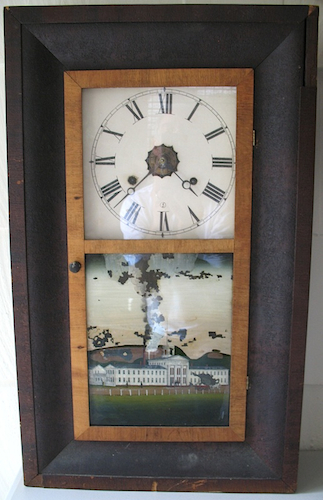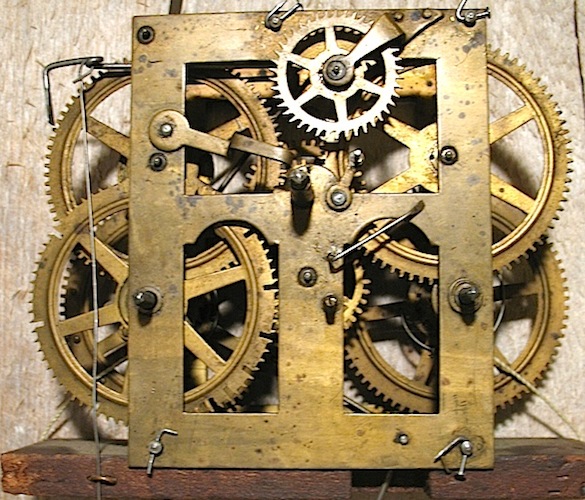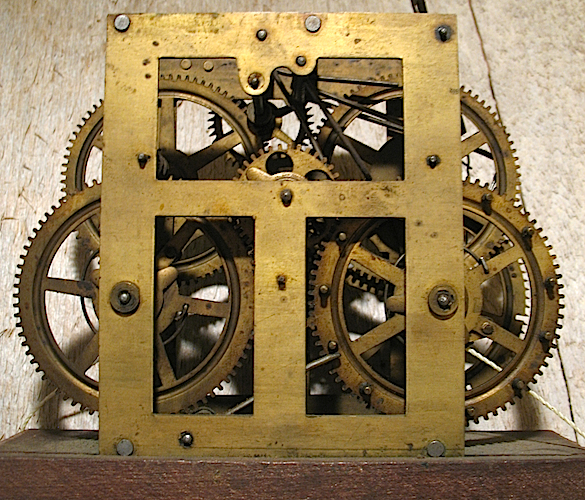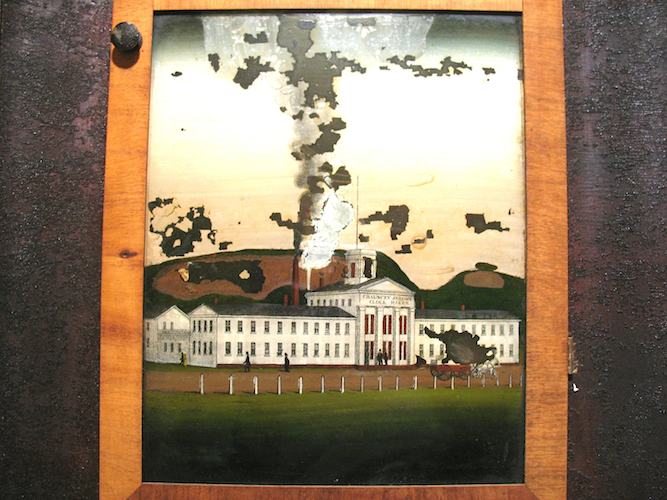The clock was made by the New Haven Clock Co. and bears a label with the trade name “Jerome & Co.” The feature that causes this clock to stand out is the tablet depicting the New Haven factory of Chauncey Jerome. Most of what follows is speculation about the significance of the tablet. The tablet was previously published in the Research Activities & News column of the March/April 2014 NAWCC Bulletin (No. 408, pg. 208). It was submitted by Lindy Larson but belonged to a friend of his. At the time of the 2014 Bulletin article there were no other examples of this tablet known. The September/October 2016 Bulletin (No. 423, pg. 423) contains another example, in a c. 1845 ogee made by H. Webster. This second example fairly conclusively resolves any questions about the originality of the tablet in my clock (as in, it isn’t). The view of the factory is looking to the north-northeast. The prominent ridge in the background is a New Haven landmark known as East Rock. The smaller hill to the right is Indian Head. East Rock is located just under a mile-and-a-quarter from the factory. This view is the only one I’m aware of that confirms an 1851 map of New Haven showing wings extending toward the back of the property. The tablet does not appear to have an artist’s signature on it.
Although the portion of the label with the printer’s line is unfortunately gone, the remnants are identical to a label printed by Goddard at 131 Union St., New Haven, CT. Freeman L. Goddard is listed in the New Haven City directories as a printer from 1867-1872. However, only the listings for 1870-1872 provide a work address for him (131 Union). Whether he was at 131 Union from 1867-1869 is unknown. It’s also not certain whether he was in business for himself from 1867-1869; he could have been apprenticing with another printer. He died Dec. 4, 1872.
Front view of the type 1.412 30-hr movement. Although Snowden Taylor speculated that the tapered escape wheel bridge found on this movement was introduced in the 1870s, I’m not aware of a reason this couldn’t be pushed a few years earlier into the late 1860s.
Rear view of the type 1.412 movement.
The door clearly stands out in contrast to the rest of the case. The case itself has its original finish. The door, on the other hand, has been stripped. The door has also been removed from the case, as the hinges attach to the door with hand-cut nails, whereas the hinges are fixed to the case with modern screws. Not only that, but the glasses have also been removed at some point. There are clear marks on the frame from where pliers were used to re-fasten the wood slats holding the glasses in. It is likely that the clock was a restoration project, and the restoration started with the door. It was removed, the glasses were then taken off, and the finish was stripped. The restoration project was abandoned and the clock reassembled. On replacing the door, screws were used as a more secure way of re-attaching it. I’d also have to say that the composition doorknob is very similar to many, many New Haven clocks I’ve seen with Goddard labels, as it is to later New Haven clocks. These knobs are far less common on earlier clocks. While not definitive, the doorknob is at least consistent with the door being original to the clock. As discussed above, though, the tablet is a marriage of a c. 1845 tablet with a late 1860s New Haven ogee. I’ve chosen to place this tablet in a period-appropriate Chauncey Jerome ogee that also did not have its original tablet.




